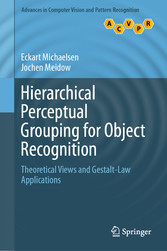Suchen und Finden
Service

Hierarchical Perceptual Grouping for Object Recognition - Theoretical Views and Gestalt-Law Applications
Eckart Michaelsen, Jochen Meidow
Verlag Springer-Verlag, 2019
ISBN 9783030040406 , 200 Seiten
Format PDF, OL
Kopierschutz Wasserzeichen
Geräte
Mehr zum Inhalt

Hierarchical Perceptual Grouping for Object Recognition - Theoretical Views and Gestalt-Law Applications
Preface
6
Contents
8
Notations
12
1 Introduction
13
1.1 Examples of Pictures with Hierarchical Gestalt
13
1.2 The State of the Art of Automatic Symmetry and Gestalt Recognition
17
1.3 The Gestalt Domain
23
1.4 Assessments for Gestalten
26
1.5 Statistically Best Mean Direction or Axis
30
1.6 The Structure of this Book
31
References
33
2 Reflection Symmetry
35
2.1 Introduction to Reflection Symmetric Gestalten
35
2.2 The Reflection Symmetry Constraint as Defined for Extracted Primitive Objects
37
2.3 Reformulation of the Constraint as a Continuous Score Function
39
2.4 Optimal Fitting of Reflection Symmetry Aggregate Features
41
2.5 The Role of Proximity in Evidence for Reflection Symmetry
43
2.6 The Role of Similarity in Evidence for Reflection Symmetry and How to Combine the Evidences
45
2.7 Nested Symmetries Reformulated as Successive Scoring on Rising Scale
47
2.8 Clustering Reflection Symmetric Gestalten with Similar Axes
53
2.9 The Theory of A Contrario Testing and its Application to Finding Reflection Symmetric Patches in Images
58
2.10 The Minimum Description Length Approach for Nested Reflection Symmetry
60
2.11 Projective Symmetry
60
References
62
3 Good Continuation in Rows or Frieze Symmetry
64
3.1 Related Work on Row Gestalt Grouping
66
3.2 The Row Gestalt as Defined on Locations
67
3.3 Proximity for Row Gestalten
69
3.4 The Role of Similarity in Row Gestalten
70
3.4.1 Vector Features
71
3.4.2 Scale Features
73
3.4.3 Orientation Features
74
3.5 Sequential Search
75
3.5.1 The Combinatorics of Row Gestalten
75
3.5.2 Greedy Search for Row Prolongation
76
3.6 The A Contrario Approach to Row Grouping
78
3.7 Perspective Foreshortening of Rows
78
References
80
4 Rotational Symmetry
82
4.1 The Rotational Gestalt Law as Defined on Locations
83
4.2 Fusion with Other Gestalt Laws
86
4.2.1 Proximity Assessments for Rotational Gestalten
86
4.2.2 Similarity Assessments for Rotational Gestalten
88
4.3 Search for Rotational Gestalten
89
4.3.1 Greedy Search for Rotational Gestalten
89
4.3.2 A Practical Example with Rotational Gestalten of Level 1
90
4.4 The Rotational Group and the Dihedral on Group
93
4.5 Perspective Foreshortening of Rotational Gestalts
93
References
95
5 Closure—Hierarchies of Gestalten
96
5.1 Gestalt Algebra
97
5.2 Empirical Experiments with Closure
101
5.3 Transporting Evidence through Gestalt Algebra Terms
103
5.3.1 Considering Additional Features
104
5.3.2 Propagation of Adjustments through the Hierarchy
106
References
111
6 Search
112
6.1 Stratified Search
112
6.2 Recursive Search
113
6.3 Monte Carlo Sampling with Preferences
114
6.4 Any-time Search Using a Blackboard
115
References
116
7 Illusions
118
7.1 Literature about Illusions in Seeing
118
7.2 Deriving Illusion from Top-down Search
119
7.3 Illusion as Tool to Counter Occlusion
119
References
120
8 Prolongation in Good Continuation
121
8.1 Related Work on Contour Chaining, Line Prolongation, and Gap Filling
122
8.2 Tensor Voting
122
8.3 The Linear Prolongation Law and Corresponding Assessment Functions
126
8.4 Greedy Search for Maximal Line Prolongation and Gap Closing
131
8.5 Prolongation in Good Continuation as Control Problem
131
8.6 Illusory Contours at Line Ends
133
References
135
9 Parallelism and Rectangularity
136
9.1 Close Parallel Contours
136
9.2 Drawing on Screens as Graphical User Interface
138
9.3 Orthogonality and Parallelism for Polygons
139
References
142
10 Lattice Gestalten
143
10.1 Related Work on Lattice Grouping
144
10.2 The Lattice Gestalt as Defined on Locations
144
10.3 The Role of Similarity in Lattice Gestalt Grouping
146
10.4 Searching for Lattices
147
10.5 An Example from SAR Scatterers
149
10.6 Projective Distortion
151
References
151
11 Primitive Extraction
153
11.1 Threshold Segmentation
154
11.2 Super-Pixel Segmentation
156
11.3 Maximally Stable Extremal Regions
158
11.4 Scale-Invariant Feature Transform
160
11.5 Multimodal Primitives
162
11.6 Segmentation by Unsupervised Machine Learning
162
11.6.1 Learning Characteristic Colors from a Standard Three Bytes Per Pixel Image
163
11.6.2 Learning Characteristic Spectra from a Hyper-Spectral Image
164
11.7 Local Non-maxima Suppression
167
References
169
12 Knowledge and Gestalt Interaction
170
12.1 Visual Inference
170
12.2 A Small Review on Knowledge-Based Image Analysis
173
12.3 An Example from Remotely Sensed Hyper-spectral Imagery
176
12.4 An Example from Synthetic Aperture RADAR Imagery
178
References
180
13 Learning
181
13.1 Labeling of Imagery for Evaluation and Performance Improvement
181
13.2 Learning Assessment Weight Parameters
184
13.3 Learning Proximity Parameters with Reflection Ground Truth
185
13.4 Assembling Orientation Statistics with Frieze Ground Truth
187
13.5 Estimating Parametric Mixture Distributions from Orientation Statistics
189
References
193
A General Adjustment Model with Constraints
195
References
197
Index
198
Shop

